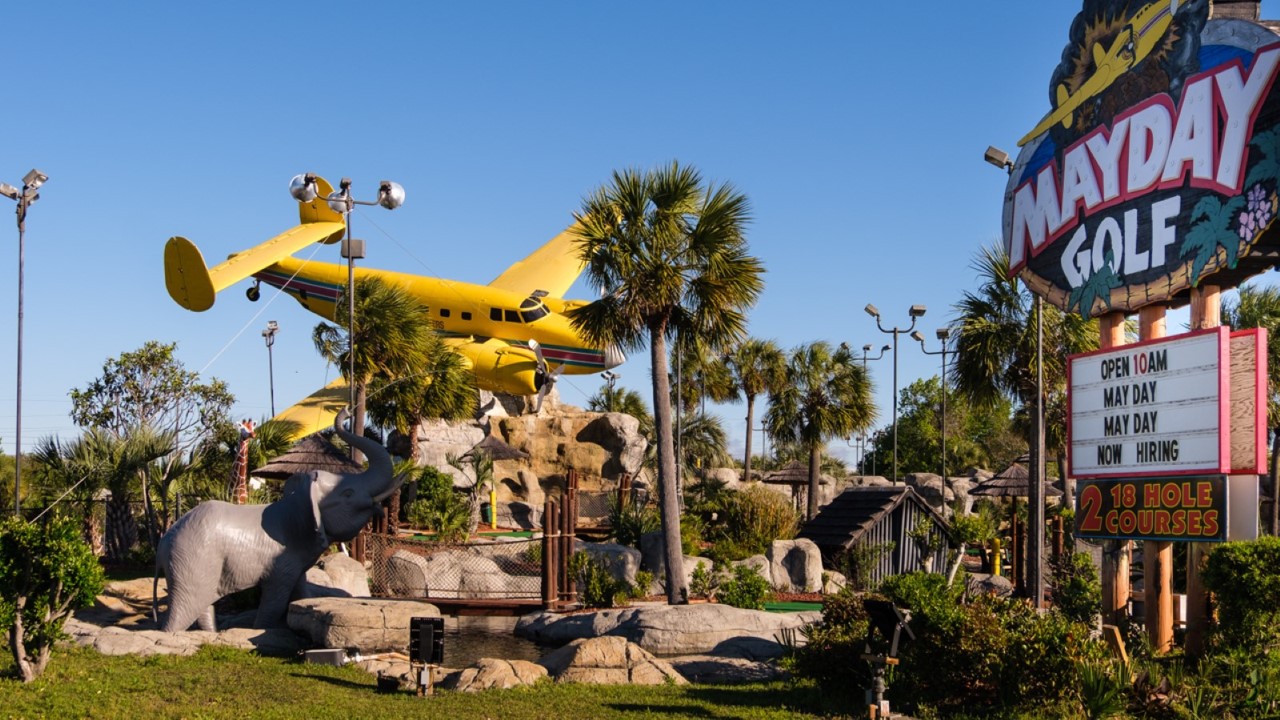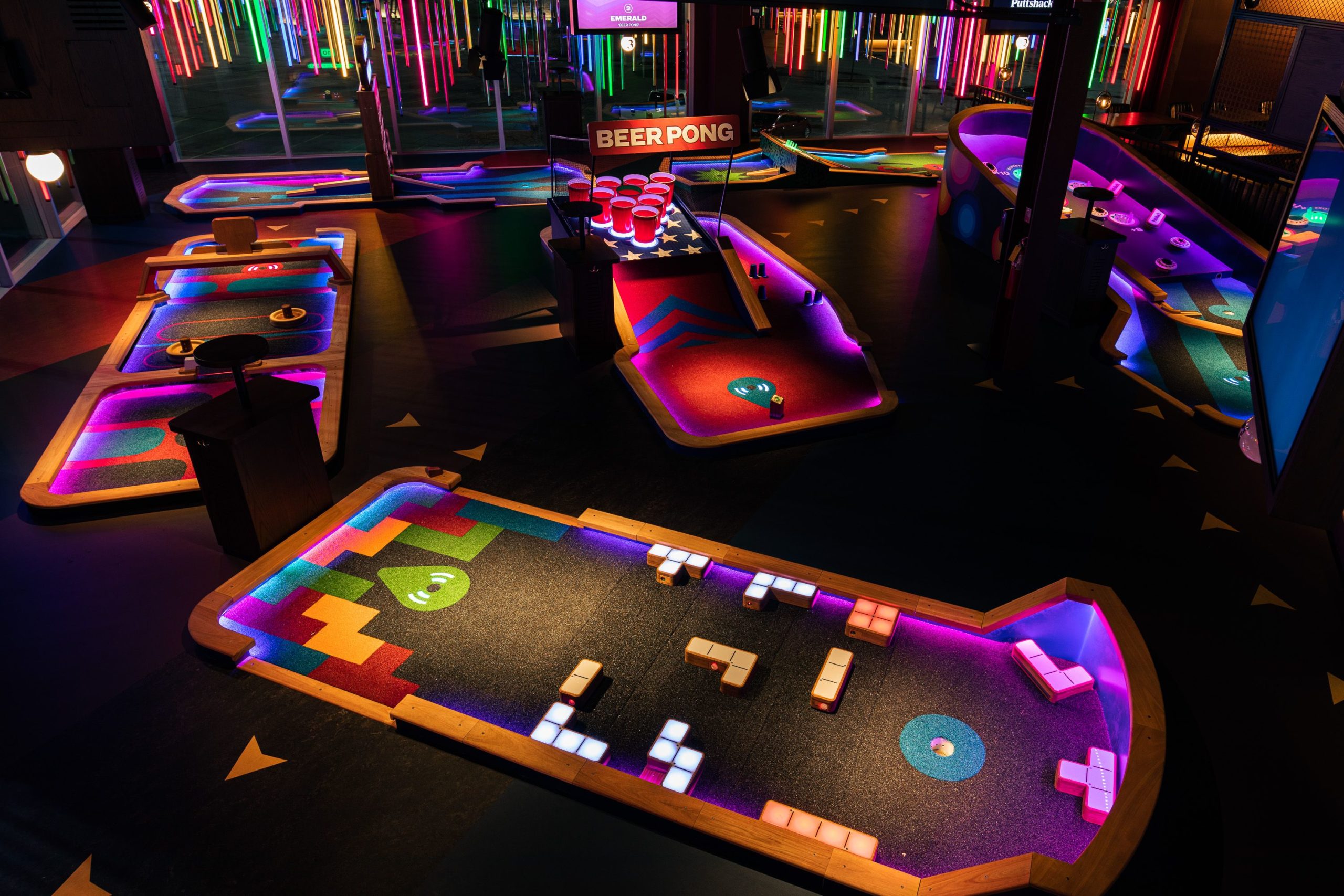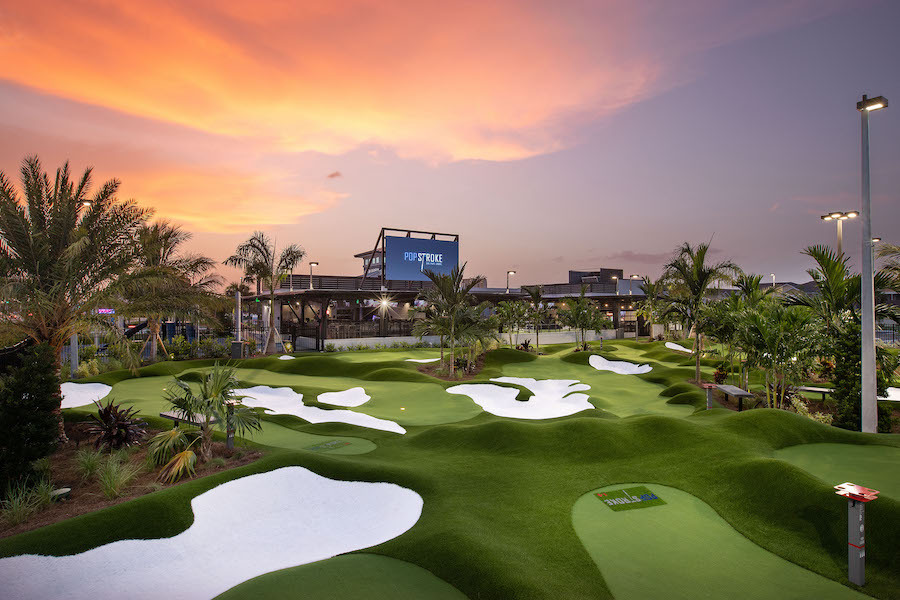Can Mini Golf Influence Interest in Traditional Golf?
The driving range category has seen significant evolution over the past decade or so. Across the country, hundreds of traditional ‘Stop and Swat’ locations have fallen by the wayside, being replaced in some markets by high-tech, high-energy golf entertainment venues – Topgolf being the top dog – that are as much about the socializing and F&B as hitting a golf ball.
In recent years, a similar shift has begun in the world of miniature golf.
Like other aspects of golf, mini golf is evolving – with new forms and concepts. Tiger Woods and Rory McIlroy have separately invested in new age, golf entertainment versions that are quite different from one another, and a far cry from old time putt-putt. A host of competitors have joined the space, with more popping up, leading to the inevitable question about what impact these kinds of “golf” experiences might have on interest in playing on a real golf course.

The classic miniature golf facility is the realm of planes, pirate ships, windmills and perhaps even a clown’s mouth. It’s likely that many current golfers first hit a golf ball with a club at a venue not unlike one of these.
The NGF has never counted miniature golf in participation measures (including in off-course forms of participation) but does track how many Americans play. In recent years, the number of mini golf participants has hovered around 18 million annually. About one-third of those are among the 25 million who play green-grass golf.
This likely won’t be a surprise for many, but the demographics of mini-golf more closely resemble that of the general U.S. population than the overall golf population. It skews younger and generally more diverse, both from a gender and ethnic makeup.
Close to one-half of mini-golfers are female (45%), a significantly higher proportion than the 24% representation in traditional golf.
Almost one quarter (22%) are juniors – versus 12% in green grass golf — and more than a half (54%) are under the age of 35. While there are more than nine million on-course golfers in that category, they account for about 36% of the U.S. golfer population.

Puttery is under the Drive Shack umbrella, offering a modern spin on mini golf with an immersive, indoor, adults-only experience and innovative technology on a variety of courses. The four U.S. venues, with more on the way, have a high-energy atmosphere that combine curated culinary offerings, craft cocktails, a lively bar area, music and putting — whether competitive or casual.
The average age of those who play mini golf is 34, closer to the representation of off-course golf (average age of 30) than on-course golf (approximately 43 years old).
While there are still thousands of old-school mini golf courses, complete with windmills, dinosaurs, loop-de-loops, pirate ships and more, some of the newer courses are much more elaborate and high-tech – places like Puttery, Puttshack, PopStroke, Swingers and Urban Putt.
And while these facilities add to golf’s renaissance of ubiquity, there’s business relevance that goes well beyond cultural significance. The demand is real, which is why Puttshack, created by the twin brothers who founded Topgolf, recently landed a $60 million investment for development of its indoor concept. The 25,000-square-foot facilities, costing up to $12 million to build, are family-focused during the day and have an adults-only, high-end nightclub vibe at night.
“We’re trying to create this whole social entertainment space. There’s a lot of things that are intermixed and obviously the technology makes it very different. But we don’t want to lose what’s really critical in creating this, which is — it’s still fundamentally the game of golf,” says Puttshack CEO Joe Vrankin, who formerly was chief executive at Topgolf.
There are currently two Puttshack locations in the U.S., with nine more openings in the next 12 months. And there are major differences from traditional mini golf beyond the look and feel, such as the Trackball technology that automatically keeps score for players, or the fact that participants are trying to get the highest score possible (based on score plus bonus points, risk-reward opportunities, holes in one, avoiding hazards and more) as opposed to the lowest score relative to par.

Puttshack combines the best parts of mini golf — the fun, accessibility and socialization – with a new game powered by seamless, modern technology, then added an exceptional food and beverage component. Since opening its first location in 2018, Puttshack now has four London locations and two U.S. locations (Atlanta and Chicago), with plans for nine more U.S. openings within the next year.
McIlroy and his Symphony Ventures Group invested at least $10 million in the development cycle for Puttery, which parent company Drive Shack describes as a “competitive socializing and entertainment golf experience” for guests 21 and older. Puttery’s first indoor location opened in September 2021 in Dallas and others are in development in major cities like Charlotte, Chicago, Houston, Miami, New York, Philadelphia, Pittsburgh and Washington D.C. The venue in Philadelphia, for example, includes three uniquely-themed nine-hole courses in a 20,000 square-foot space that also includes multiple bars, music and an active food and beverage presence.
“Putting is not intimidating and people really enjoy it, so I think that we hit the sweet spot with golf,” says DriveShack CEO Hana Khouri. “We’re trying to redo what people think of as mini-golf or putt-putt and really putting our own twist on it. The market is huge for what we’re doing with Puttery.”
Woods, meanwhile, has a strategic partnership with PopStroke, which has four outdoor locations in Florida – Fort Myers, Orlando, Port St. Lucie and Sarasota – with more on the way, including in Houston and Glendale, Arizona. Woods’ design business is responsible for the layout of the putting courses at all PopStroke locations and doesn’t shy away from “golf” being a core element of the product as evidenced by his recent comment about the Orlando location’s opening.
“PopStroke is about bringing friends and families together to create lasting memories around the game of golf,” said Woods, who recalls the childhood putting competitions he had with his father as a reason he wanted to align with PopStroke. “We look forward to welcoming a new generation of players to our unique putting experience.”

PopStroke recently opened its newest Florida location in Orlando.
The synthetic turf putting courses he’s helped create certainly aren’t simple and straightforward. There are undulations, bunkers and rough like one would find on a traditional golf course. The two layouts at the newest Florida location in Orlando differ in challenge: the Red Course features strong contouring and tricky hole locations, while contours at the Black Course are softened to make it easier for families and those newer to the game. The venue also features an outdoor dining area with a full menu and craft beer, wine, and signature cocktails along with an ice cream parlor, outdoor game area, and a playground.
It’s clear the social element plays a key role in the experience – from the music, technology and F&B at the newer mini golf venues to more traditional mini golf facilities trying outside-the-box approaches.
Take Olde Saratoga Miniature Golf in upstate New York, which has embraced the social smoking movement with some green on the greens. The facility’s operator has introduced an event called Puff-Puff-Putt, an open-air, 21-and-older, pot-smoking Tuesday night for mini-golfers.
Tipsy Golf, which is billed as a local craft beer mini golf experience, is soon coming to the golf mecca that is California’s Monterey Peninsula, with plans to open this fall after signing a retail lease on bustling Cannery Row.
It’s hard to argue these unique forms of mini golf are geared for both golfers and non-golfers.
Yet the dedicated putting courses that have sprung up at golf resorts in recent years are definitely targeted at serious traveling golfers looking to have fun. These include putting courses like Thistle Dhu at Pinehurst, The Punchbowl at Bandon Dunes, The Drumlin at Erin Hills, HillTop at Forest Dunes, and the recently-announced Bucket at Streamsong that will be about twice the size of the resort’s current putting course, The Gauntlet. Depending on the site, full 18-hole putting courses of around two acres can cost as little as $50,000 at locations with pure sand, and potentially closer to $1 million in areas with heavy soil that want USGA putting specs.

Aerial view of the Thistle Dhu putting course outside the main clubhouse at Pinehurst in North Carolina.
These courses point to the golfer demand for fun, rollicking putting challenges – especially ones that require carrying just one club and one ball, leaving the other hand free for a beverage.
Does it go the other way, too? Can putting on a mini-golf course encourage participants to want to try a full set of clubs on a real course?
NGF surveys show that mini-golfers, like off-course participants, generally express an above average interest in playing green-grass golf.
Of those who played miniature golf, 16% said they were “very” interested in trying golf; this is not too far off from the 25% of non-golfers with Topgolf experience who express similar interest. Among those who have never played any forms of golf, only 4% said they were very interested in trying to take up the traditional game. Just getting a club in a non-golfer’s hands, even a putter, is a start.
So, it’s possible that growing the game might take place at the smallest of venues.
____________________________________________________________________
For perspective from NGF President and CEO Joe Beditz on the evolution of mini golf, CLICK HERE
For member-only “Vault” visuals on mini golf participation, CLICK HERE
To access a member-only, one-page overview of the Off-Course golf segment, CLICK HERE
Short Game.
"*" indicates required fields
How can we help?
NGF Membership Concierge

"Moe"
Learn From NGF Members
 Ship Sticks Secrets to a Hassle-Free Buddies Golf Trip
Ship Sticks Secrets to a Hassle-Free Buddies Golf Trip
Whether you’re the head planner of your upcoming buddies golf trip or simply along for the ride, we’ve gathered a few easy ways to keep everyone in your group happy.
Read More... Golf Course Turf, Soil and Water Quality Diagnostic Testing
Golf Course Turf, Soil and Water Quality Diagnostic Testing
As humans, we see our primary care physician on a regular basis to proactively evaluate our vital signs. Likewise, a superintendent should perform frequent diagnostic testing on their golf course.
Read More... Unlocking Distance: Launch Conditions and Angle of Attack
Unlocking Distance: Launch Conditions and Angle of Attack
We’ve long known that higher launch and lower spin is a powerful combination for generating consistently long and straight tee shots. A key factor in optimizing launch conditions, one often overlooked, is ...
Read More...



